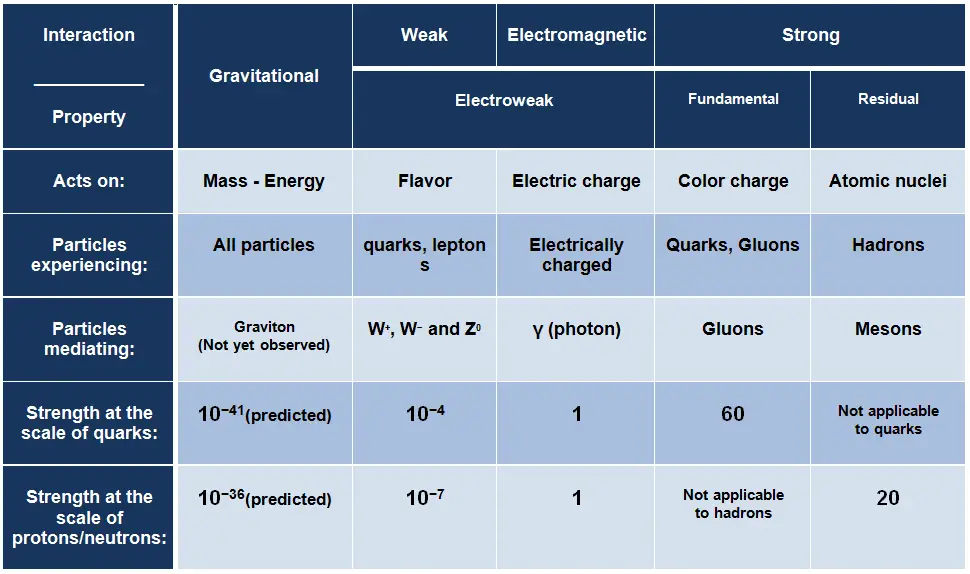The universe, in all its splendor and complexity, is governed by a limited number of fundamental forces. Among these, two prominent interactions — the strong force and the weak force — play crucial roles in shaping the atomic and subatomic realms. Their distinct characteristics, impacts, and implications contribute significantly to our understanding of physical phenomena from the subatomic to cosmic scales.
To appreciate these forces fully, it is essential to first delineate their classifications within the standard model of particle physics. The strong force, also referred to as the strong nuclear force or strong interaction, is responsible for holding protons and neutrons together in atomic nuclei. Contrarily, the weak force, characterized as the weak nuclear force, is responsible for processes that govern radioactive decay and certain types of particle interactions.
Understanding the Strong Force
The strong force is arguably the most potent of the four fundamental interactions, with a strength that dwarfs that of gravity and electromagnetism. However, its influence is profoundly local. This formidable force acts over a range of approximately one femtometer (10^-15 meters) — roughly the scale of atomic nuclei. At this scale, the strong force binds quarks together to form protons and neutrons, the building blocks of atomic nuclei.
Quarks, which are elementary particles, carry a property known as “color charge.” This property is analogous to the concept of electric charge but exists in three types: red, green, and blue. The theory that describes the strong force is known as quantum chromodynamics (QCD). QCD posits that the color charge is exchanged between quarks via particles called gluons, which act as mediators of the strong force. These interactions cause quarks to remain confined within particles like protons and neutrons, creating a phenomenon known as confinement.
Furthermore, within atomic nuclei, protons and neutrons experience an additional layer of complexity. Although protons are positively charged and should repel each other due to electromagnetic forces, the strong force effectively overcomes this repulsive interaction, permitting atomic stability. The binding energy associated with this force can be significant, and it is this energy that is liberally released in nuclear reactions, exemplified by both nuclear fission and fusion processes.
Insights into the Weak Force
In stark contrast, the weak force operates on a much more extensive range and exhibits a considerably different nature. Its mediators, the W and Z bosons, impart the force with the ability to affect particles over distances beyond a femtometer, albeit still restricted compared to the other fundamental forces. The weak force is pivotal in nuclear beta decay, where a neutron transforms into a proton or vice versa, emitting a beta particle (an electron or positron) and a neutrino in the process.
This decay process not only facilitates the transmutation of elements but also contributes to the universe’s elemental abundance — a stark implication of the weak force in physical cosmology. The weak force operates through the exchange of W and Z bosons, facilitating interactions that alter the flavors of quarks and thereby change one type of particle into another. This transformative ability underscores the weak force’s significance in particle physics and its underlying symmetries.
Contrast and Duality: Strong vs. Weak
While both forces are considered fundamental in the sense that they characterize the workings of matter, their operational principles, manifestations, and consequences delineate a fascinating dichotomy. The strong force’s potency is countered by its short range, creating a compelling narrative of force and confinement. In contrast, the weak force’s ability to instigate transformation across longer distances lends a remarkable dynamic to particle interactions, albeit with relatively low strength. This dichotomy hints at the eclectic nature of the universe, where contrasting behaviors conspire to produce rich and intricate structures.
Moreover, the interplay between these two forces contributes to a myriad of phenomena observed in the universe. For example, during stellar nucleosynthesis, the strong force binds nuclei together, while the weak force governs the processes leading to the fusion reactions that fuel stars. The complex relationship engendered by the interplay of these forces is a cornerstone of astrophysics, enabling the birth and evolution of the cosmos.
Reflecting on the Fascinations of Strong and Weak Forces
The strong and weak forces encapsulate the essence of nature’s intricacies. Their exploration challenges physicists to probe deeper into the fabric of reality, delving into realms that blur the boundaries between energy and matter. Despite their well-defined roles within the standard model, the quest to unravel their nuances continues to inspire inquiry. Questions surrounding their unifications, potential ties to gravitation, and implications for higher-dimensional theories fuel theoretical endeavors, including string theory and beyond.
In essence, while the strong force embodies the principle of cohesion crucial to atomic stability, the weak force introduces the notion of transformation — a transformative dance that evinces the dynamic nature of the universe. Ultimately, both forces contribute to the rich tapestry of reality, from the microscopic world of particles to the vastness of galaxies. The exploration of these fundamental interactions not only illuminates the workings of our universe but captivates the imagination, prompting wonder and inspiring further inquiry into the profound mysteries that remain.












